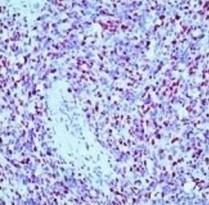ARG20575
anti-Myogenin antibody [F12B]
anti-Myogenin antibody [F12B] for ICC/IF,IHC-Formalin-fixed paraffin-embedded sections,Immunoprecipitation,Western blot and Human,Mouse,Rat
Developmental Biology antibody; Gene Regulation antibody
Overview
| Product Description | Mouse Monoclonal antibody [F12B] recognizes Myogenin |
|---|---|
| Tested Reactivity | Hu, Ms, Rat |
| Tested Application | ICC/IF, IHC-P, IP, WB |
| Host | Mouse |
| Clonality | Monoclonal |
| Clone | F12B |
| Isotype | IgG1 |
| Target Name | Myogenin |
| Antigen Species | Mouse |
| Immunogen | Recombinant protein around aa. 30-224 of Rat myogenin and Mouse myeloma NS1 cells. |
| Conjugation | Un-conjugated |
| Alternate Names | Myogenin; MYF4; Myf-4; bHLHc3; Class C basic helix-loop-helix protein 3; Myogenic factor 4 |
Application Instructions
| Application Suggestion |
|
||||||||||
|---|---|---|---|---|---|---|---|---|---|---|---|
| Application Note | * The dilutions indicate recommended starting dilutions and the optimal dilutions or concentrations should be determined by the scientist. | ||||||||||
| Positive Control | Rhabdomyosarcoma and Wlim's tumors |
Properties
| Form | Liquid |
|---|---|
| Purification | Purification with Protein A/G. |
| Buffer | PBS and 0.08% Sodium azide |
| Preservative | 0.08% Sodium azide |
| Storage Instruction | For continuous use, store undiluted antibody at 2-8°C for up to a week. For long-term storage, aliquot and store at -20°C or below. Storage in frost free freezers is not recommended. Avoid repeated freeze/thaw cycles. Suggest spin the vial prior to opening. The antibody solution should be gently mixed before use. |
| Note | For laboratory research only, not for drug, diagnostic or other use. |
Bioinformation
| Database Links | |
|---|---|
| Gene Symbol | Myog |
| Gene Full Name | myogenin |
| Background | This gene belongs to the myogenic factor subfamily of the basic helix-loop-helix (BHLH) family of transcription factors. The protein encoded by this gene is a muscle-specific skeletal myogenin, which acts in concert with other family members to regulate myogenesis. The protein plays an essential role in the conversion of undifferentiated cells to myoblasts and functional skeletal muscle. [provided by RefSeq, Jul 2008] |
| Function | Acts as a transcriptional activator that promotes transcription of muscle-specific target genes and plays a role in muscle differentiation, cell cycle exit and muscle atrophy. Essential for the development of functional embryonic skeletal fiber muscle differentiation. However is dispensable for postnatal skeletal muscle growth; phosphorylation by CAMK2G inhibits its transcriptional activity in respons to muscle activity. Required for the recruitment of the FACT complex to muscle-specific promoter regions, thus promoting gene expression initiation. During terminal myoblast differentiation, plays a role as a strong activator of transcription at loci with an open chromatin structure previously initiated by MYOD1. Together with MYF5 and MYOD1, co-occupies muscle-specific gene promoter core regions during myogenesis. Cooperates also with myocyte-specific enhancer factor MEF2D and BRG1-dependent recruitment of SWI/SNF chromatin-remodeling enzymes to alter chromatin structure at myogenic late gene promoters. Facilitates cell cycle exit during terminal muscle differentiation through the up-regulation of miR-20a expression, which in turn represses genes involved in cell cycle progression. Binds to the E-box containing (E1) promoter region of the miR-20a gene. Plays also a role in preventing reversal of muscle cell differentiation. Contributes to the atrophy-related gene expression in adult denervated muscles. Induces fibroblasts to differentiate into myoblasts. [UniProt] |
| Research Area | Developmental Biology antibody; Gene Regulation antibody |
| Calculated MW | 25 kDa |
| PTM | Phosphorylated by CAMK2G on threonine and serine amino acids in a muscle activity-dependent manner. Phosphorylation of Thr-87 impairs both DNA-binding and trans-activation functions in contracting muscles (By similarity). |
Images (1) Click the Picture to Zoom In






